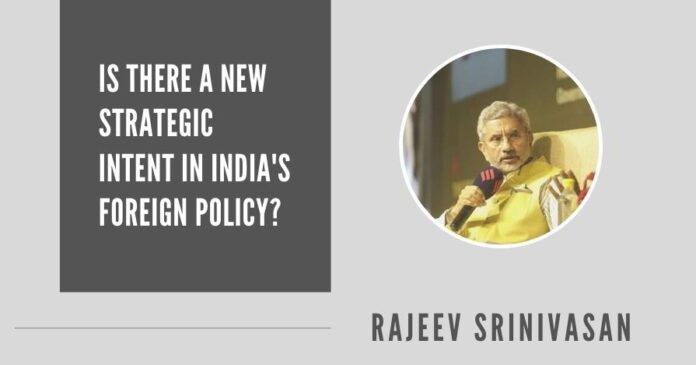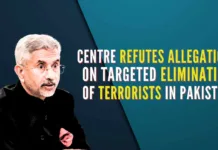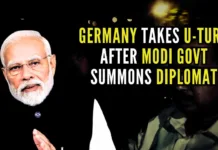
What struck me while listening to the 45-minute speech was the relevance of several concepts from the world of business.
India’s Minister of External Affairs (MEA), Subrahmanyam Jaishankar, delivered the Ramnath Goenka lecture in November wherein he seems to suggest a new direction in India’s foreign policy.
In sum, the MEA suggested that there have been six phases in India’s evolving foreign policy journey and that the massive change happening today is unprecedented.
The MEA then gave an overview of today’s complex issues, which he suggested could fall into five baskets, although there is some overlap amongst the baskets. Some may need us to take risks, others to exert buyer power, yet others to be thought through carefully.
The strategic intent should be to make it a G3, India as one of the major poles of the world order. The other contenders, Russia and the EU, have serious problems.
India’s vision statement
What struck me while listening to the 45-minute speech[1] was the relevance of several concepts from the world of business. Perhaps this is not surprising, because a business strategy is essentially a repackaging of the military and national strategy in the first place.
Most relevant are the notions of strategic intent and the concomitant core competence, as well as the notion that leaders in one phase of an evolving system often do not retain leadership in the next phase.
Strategic intent, first articulated by the management guru C K Prahalad, suggests that organizations should have a well-conceived long-term goal, one that is quantifiable.
As distinct from vision statements, strategic intents are precise so that progress towards them are measurable. In addition, the intent is a stretch goal, ie. one that will not come without innovative effort. Also, they are exciting goals that get people to think creatively.
How Canon beat Xerox
For example, fledgeling Canon had the goal, “Beat Xerox in 10 years”. And indeed they did, by changing the rules of the game: small, portable, personal copiers instead of large, department size products.
Strategic intent should not be confused with a traditional strategic plan, which attempts to fit the current capability into a medium-term objective. Intent is a game-changer.
An interesting example of strategic intent is the (possibly apocryphal) statement attributed to George Kennan, who articulated the US’ foreign policy goals as follows (I paraphrase):
“The US has 8% of the world’s population but enjoys 35% of the world’s resources. The goal of our foreign policy is to keep it that way”. That’s exactly what they have proceeded to do.
China has laid out its strategic intent: Made in 2025 for leadership in strategic industries, and dominance in economic and military power by 2050, the centenary of their revolution.
India has been too reticent to articulate such an audacious or clear intent. It has been satisfied with being an also-ran, despite the fact that by 2030, it is likely to overtake Japan and Germany and become the third-largest economic power in the world.
The MEA’s statements hint that at a strategic intent now for India. There has also been the clear statement about hitting $5 trillion by 2025, although that is unlikely because that would require sustained GDP growth levels that seem unrealistic at the moment.
The strategic intent should be to make it a G3, India as one of the major poles of the world order. The other contenders, Russia and the EU, have serious problems.
There is also a necessary condition, which is resources and capabilities leading to core competencies. There are difficult questions about what India’s core competencies might be. ‘Services’ is not a good answer. ‘Technology’ isn’t either, given our poor R&D.
There needs to be greater realism: unsettled borders and unending border ‘talks’ with China and Pakistan are an unnecessary irritant and need resolution.
Phases
It is a given in industry that phase changes usually create chaos, and that new champions come up. A good example is the computer industry. Initially, it was IBM with the mainframe; then came DEC with the minicomputer; next Sun with its engineering workstation.
Finally came Microsoft and Intel with the Windows PC. And today, in some sense, the PC is being supplanted by the mobile phone, led by Apple and Google.
So leadership changed hands, and the playing field changed: that is the norm.
Let us consider the phases of India’s foreign policy environment as the MEA identified them:
- 1946-62, Non-Aligned Movement optimism, bipolar Cold War world view
- 1962-71: realism and recovery from the shock of 1962. Thinking beyond NAM
- 1971-1991: regional assertion, but IPFK misadventure. Sino-US rapprochement and the collapse of traditional friend USSR. Potent US-China-Pak axis develops
- 1991-1998: unipolar world, India’s quest for strategic autonomy, the nuclear option
- 1998-2014: unipolarity declines, India tries to a balancing power. A nuclear deal with the US. But BRICS and climate change connect to China
- 2014 onwards: dealing with China’s momentum. America withdraws. Indo Pacific thrust with Japan’s re-emergence. Multipolarity. EU turns inwards.
The point is that as these phases change, India’s opportunities and options change as well. Friend and foe take on different hues. India has to change and roll with the punches.
Old dogmas will not work, India needs to be flexible. There is also a need to be assertive, and for that, there needs to be self-belief and self-confidence. India is beginning to get there.
One of the difficulties is that there is an entrenched cadre of foreign service officers who have internalized the non-alignment dogma, even though today the mantra might be multi-alignment.
There is a lack of training and practice: there is the general Indian attitude that they can make up for lack of preparation with last-minute heroics. This doesn’t work. They must be taught Game Theory and drilled with computer simulations of complex scenarios.
Besides, the current environment is more complex, with ever-changing alliances and influences, especially in our own backyard: see how the Maldives, Sri Lanka, and Nepal are being enticed by the Chinese, as they begin to contest India’s natural dominance in the Indian Ocean.
There needs to be greater realism: unsettled borders and unending border ‘talks’ with China and Pakistan are an unnecessary irritant and need resolution.
South China Sea shenanigans and trade wars will worsen, and there might be a Thucydides Trap war between the US and China. India should watch, keep away from the war, and try to exploit opportunities that come up. These are interesting times in our neighbourhood.
Note:
1. The views expressed here are those of the author and do not necessarily represent or reflect the views of PGurus.
References:
[1] Full speech: EAM Dr S Jaishankar delivers 4th RNG lecture 2019 | Indian Express Nov 14, 2019, YouTube.com
- The lament of the Kulaks - February 11, 2021
- Animal rights: violations everywhere, but only India is targeted by PETA busybodies - November 24, 2020
- CAA Riots and the Role of Technology - February 2, 2020











[…] खबर को अंग्रेजी में यहाँ […]
The key to any change, be it foreign policy or economic revamp etc., the basic fundamental requirement is a change in attitude from within and it should start with the political mindset wherein honesty, integrity and nationalism should first take precedence to everything else. A nation that is fighting within from among political ideologies, religious dogma and from corruption cannot climb out into a world that has determined its own path by allowing these precedences to dictate its foreign policies.